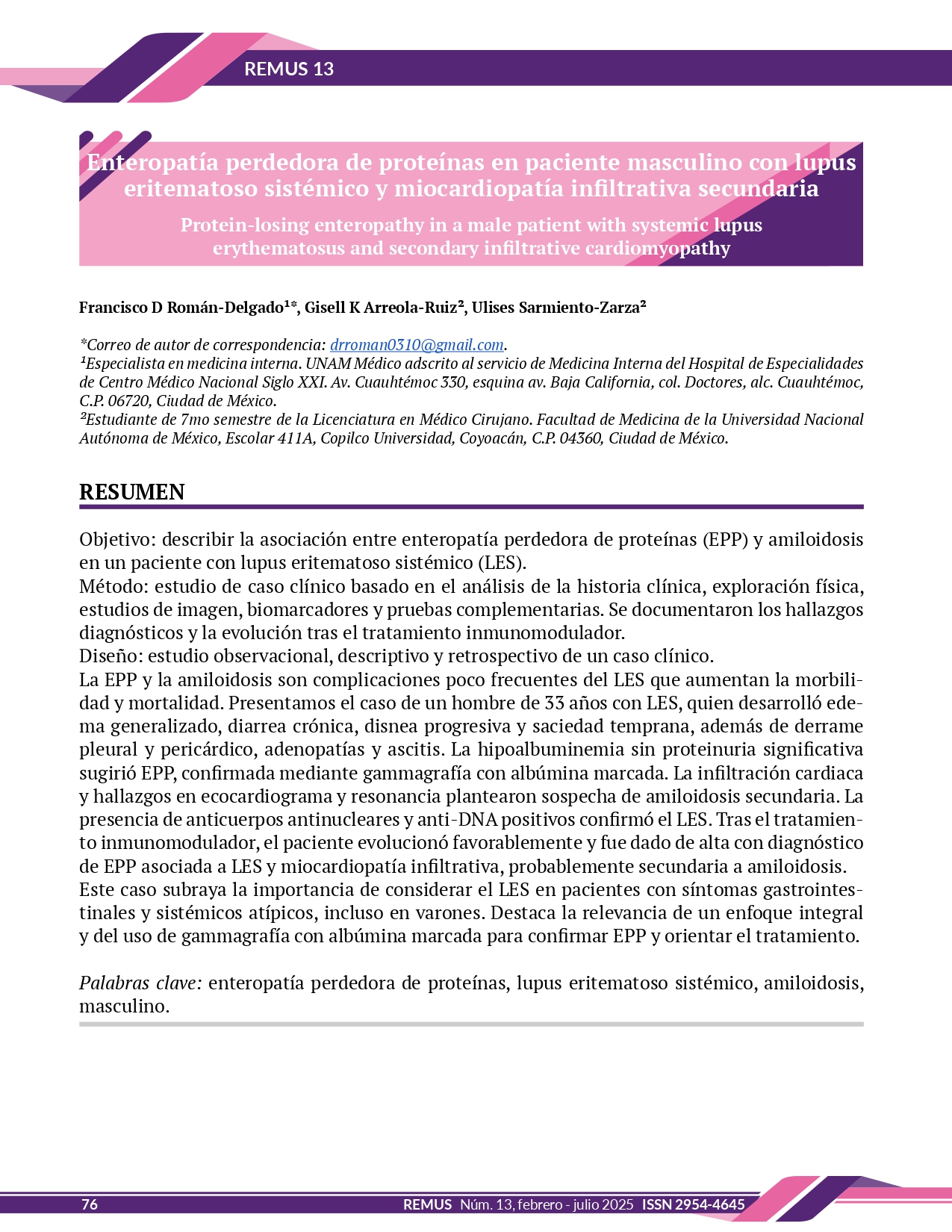Protein-losing enteropathy in a male patient with systemic lupus erythematosus and secondary infiltrative cardiomyopathy
Case report
DOI:
https://doi.org/10.59420/remus.13.2025.271Keywords:
PLD, SLE, male, amyloidosisAbstract
Protein-losing enteropathy (PLE) and amyloidosis are uncommon complications of systemic lupus erythematosus (SLE) that can increase morbidity and mortality. We describe the case of a 33-year-old man with SLE who presented with generalized edema, chronic diarrhea, progressive dyspnea, and early satiety, as well as pleural and pericardial effusions, lymphadenopathy, and ascites. Initial studies revealed hypoalbuminemia without significant proteinuria, suggesting PLE, which was confirmed by an albumin-labeled gammagram. The presence of cardiac infiltration and findings on echocardiogram and MRI raised suspicion of secondary amyloidosis. The detection of positive antinuclear antibodies and anti-DNA antibodies confirmed the diagnosis of SLE. After receiving immunomodulatory treatment, the patient showed favorable progress and was discharged with a diagnosis of PLE associated with SLE and infiltrative cardiomyopathy, likely secondary to amyloidosis.
This case highlights the importance of suspecting SLE in patients with atypical gastrointestinal and systemic symptoms, even in men, where it is less common. It also emphasizes the need for a broad diagnostic approach and appropriate management of these complications to optimize clinical outcomes and reduce the risk of mortality. The albumin-labeled gammagram was crucial in confirming the diagnosis and guiding treatment in this complex context.
Downloads
References
- Tian J, Zhang D, Yao X, Huang Y, Lu Q. Global epidemiology of systemic lupus erythematosus: a comprehensive systematic analysis and modelling study. Ann Rheum Dis. 2023;82(3):351–6. https://doi.org/10.1136/ard-2022-223035
- Alharbi S. Gastrointestinal Manifestations in Patients with Systemic Lupus Erythematosus. Open Access Rheumatology: Research and Reviews. 2022 Oct 17;14:243–53. https://doi.org/10.2147/oarrr.s384256
- Frittoli RB, Vivaldo JF, Costallat LTL, Appenzeller S. Gastrointestinal involvement in systemic lupus erythematosus: A systematic review. Journal of Translational Autoimmunity. 2021;4:100106. https://doi.org/10.1016/j.jtauto.2021.100106
- Luca Ellia, Matilde Topa, and Alessandro Rimondia. Protein-losing enteropathy. Current Opinion in Gastroenterology, editor. 020,36(3):238-244. https://doi.org/10.1097/mog.0000000000000629
- Elli L, Topa M, Rimondi A. Protein-losing enteropathy. Curr Opin Gastroenterol. 2020 May;36(3):238-244. https://doi.org/10.1097/mog.0000000000000629
- Tovar LP, Sanabria NJ, Fernández-Ávila DG, Díaz C, Martín J. Lupus eritematoso sistémico y amiloidosis: una asociación poco frecuente. Revista Colombiana de Reumatología. 2015 feb 27;22(1):59–62. https://pesquisa.bvsalud.org/portal/resource/pt/lil-765635

Downloads
Published
How to Cite
Issue
Section
License
Copyright (c) 2025 REMUS - Revista Estudiantil de Medicina de la Universidad de Sonora

This work is licensed under a Creative Commons Attribution-NonCommercial-NoDerivatives 4.0 International License.

